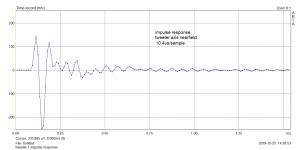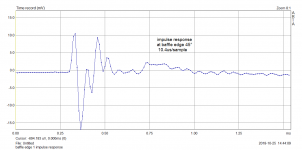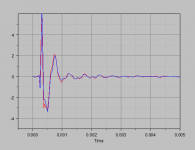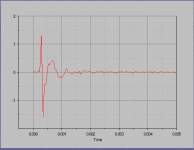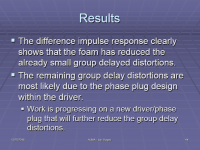There were not many conclusions to be drawn after all that text.
So sod the text and look at pictures. Measurements > talking.
Diffraction from baffle edges
YouTube
There's lots of basic background info in this video, so jump to approx 4:30 and 10:00 for the good bits.
The clip gives good support for doing a chamfer rather than a simple rectangle - and the chamfer doesn't have to be ridiculously huge, as some suggest.
Here is a good example how low diffractions can be in a basically standard narrow floorstander. Narrowing front baffle aroud tweeter and chamfered edges. Nicely mounted drivers with exceptional radiator profile - shallow dome or inverted dome. Smart xo and time alignment.
So, to me this shows that baffle shape doesn't have to be special. Besides Tidal, Magico can do this too.
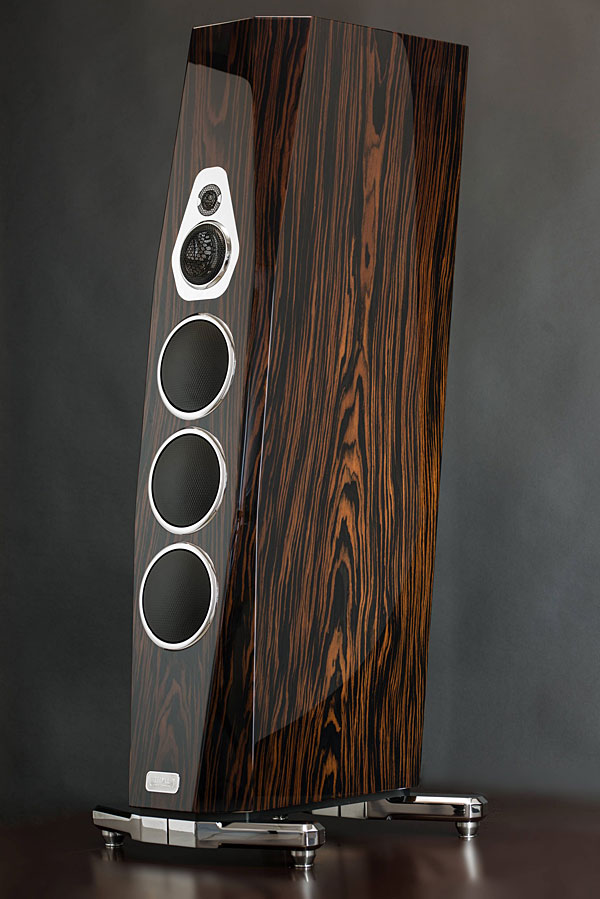
Normalized horizontals
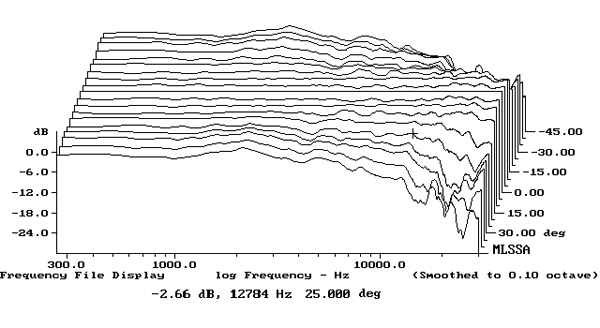
Tidal Audio Akira loudspeaker Measurements | Stereophile.com
So, to me this shows that baffle shape doesn't have to be special. Besides Tidal, Magico can do this too.

Normalized horizontals

Tidal Audio Akira loudspeaker Measurements | Stereophile.com
Linkwitz shows that diffraction just isn't an audible problem except maybe a bit for minuscule sized boxes.
His data, which indicate little harm from diffraction, are absolutely worst-case. And these tests are further worse because being purely on-axis and anechoic, they miss the Peter/Paul principle (even with diffraction occurring, total room sound is not changed).
B.
As a dipole aficionado, isn't the aim to get a diversity of secondary sources and would they maybe become less distinct the more you add?
they miss the Peter/Paul principle (even with diffraction occurring, total room sound is not changed).
I don't know who Peter and Paul are but I know Huygens–Fresnel
Huygens–Fresnel principle - Wikipedia
I don't know who Peter and Paul are but I know Huygens–Fresnel[/url]
... even if there is wee bit of diffraction, the total sound the driver puts into your room is the same. Like the old expression, borrowing from Peter to pay Paul.
B.
Ben - it's not "the total sound the driver puts into your room is the same" that matters. In fact, regarding this discussion, it is completely irrelevant. Image is the direct sound NOT the reverberant sound. I keep telling you this and you keep making these pointless claims. Makes me think you are not taking any of this serious. Just arguing to argue.
Last edited:
As a dipole aficionado, isn't the aim to get a diversity of secondary sources and would they maybe become less distinct the more you add?
That is true, mess things up enough and you won't hear the diffraction. You also won't hear any imaging either. Doesn't sound to me like what I would want to do.
Perhaps it has been a long time since you read Toole's book.Ben - it's not "the total sound the driver puts into your room is the same" that matters.
Without disputing the exact role of direct sound (which, like Linkwitz and other dipole enthusiasts I might wonder about), I have yet to hear any intelligent reason to think that diffraction has anything to do with image localization.In fact, regarding this discussion, it is completely irrelevant. Image is the direct sound NOT the reverberant sound.
Want to try to explain how diffraction affects localization?*
And please do not again accuse me of trolling.
B.
*Maybe localization would have an effect for a recording of a marching band walking around. Not sure.
Toole never talks about imaging, its not on his radar. It's one area where we don't necessarily disagree, he just doesn't make any mention of it. It has to do with the type of music that one listens to. Studio versus in-situ venue. There is virtually no image on in-situ venue recordings for a multitude of reasons. Studio recordings can have amazing imaging on the other hand. Neither Toole or Linkwitz ever listen to studio recordings. Their interest in purely in the in-situ venue stuff. Mine is almost exclusively studio work.
I explained this back in Baffle Diffraction and Baffle Diffraction, but you seem not to have read them or somehow discount them.
If it sounds like a troll and reads like a troll then it must be a troll.
I explained this back in Baffle Diffraction and Baffle Diffraction, but you seem not to have read them or somehow discount them.
If it sounds like a troll and reads like a troll then it must be a troll.
i thought a dipole had a null at 90 from on axis?
in a small room would that not remove diffraction/re-radiation from the adjacent wall?
one would think that it would succeed in creating a circumstance where direct sound from the driver is favored and is able mask any diffraction?
in a small room would that not remove diffraction/re-radiation from the adjacent wall?
one would think that it would succeed in creating a circumstance where direct sound from the driver is favored and is able mask any diffraction?
The null is formed due to cancellation of 2 waves. The cancellation is highest near the edge of the driver, hence diffraction is higher there.i thought a dipole had a null at 90 from on axis?
It would be interesting to know whether there is diffraction in this plane away from the driver?
Last edited:
There is virtually no image on in-situ venue recordings for a multitude of reasons.
I am not sure about this, especially in case we speak about smaller chamber orchestra. One example
Linn Records - Chrysalis: Cello works by Haydn, Couperin, Monn
where the cello soloist sits in the middle and the ensemble makes the semi-circle behind her. It can be clearly heard from the recording made in Usher Hall, Edinburgh.
i thought a dipole had a null at 90 from on axis?
in a small room would that not remove diffraction/re-radiation from the adjacent wall?
one would think that it would succeed in creating a circumstance where direct sound from the driver is favored and is able mask any diffraction?
An ideal dipole would have that in full spectrum of music. But there is no such thing in this reality...
Loud backside radiation has also wide coverage angle and if front-wall is close, time delay is short enough to mess the "direct sound" and it really does that (comb filtering). Angulation of say 30¤ helps a lot by attenuating the reflected sound!
From Linkwitz
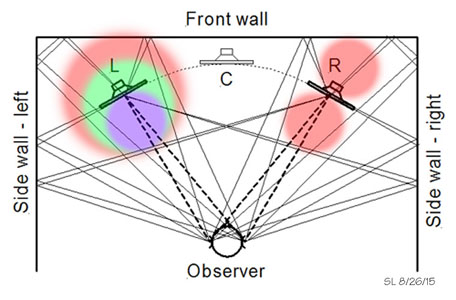
I am not sure about this, especially in case we speak about smaller chamber orchestra.
Of course there will be exceptions, but as a general rule the more instruments and the bigger the venue the less imaging there will be when compared to studio work where the imaging can be quite precise. There will be overlap - good imaging on in-situ venue recordings (as you note) and poor imaging on studio work (often done deliberately), but I'll stand by my "general rule" comment.
To others, please do not confuse diffraction with reflection. We have already been through why the two things are significantly different.
Toole never talks about imaging, its not on his radar. It's one area where we don't necessarily disagree, he just doesn't make any mention of it. It has to do with the type of music that one listens to. Studio versus in-situ venue. There is virtually no image on in-situ venue recordings for a multitude of reasons. Studio recordings can have amazing imaging on the other hand. Neither Toole or Linkwitz ever listen to studio recordings. Their interest in purely in the in-situ venue stuff. Mine is almost exclusively studio work.
err.. 😱
Toole: Sound Reproduction (1st ed.):
Chapters 6 & 8, in the title alone containing "Images", and "Imaging" (respectively).
Toole also used "popular" music in his testing (..which was not a "venue" type recording at all, and I'm not sure his "Jazz" tests were either). Don't know about SL (RIP), I'm pretty sure that most of his collection was of the venue type and orchestral specifically, but he might well have had other genres of music to sample from time-to-time.
As for the contention that venue recordings don't generally have imaging.. in relation to distance I'd argue that they very much do. I'd also argue that a well done venue recording tends to have better imaging in the depth plane (and depending on the type of music/instrumental - is often more "3D" as a result). ..I'd agree though that lateral effects are almost always superior on a "studio" basis. 🙂
..while not exactly "on-point", I'll take AC/DC LIVE! over any of their studio-stuff. 😀
-in fact I think I'll go get "Thunderstruck" right now.. 😎
I'll have to review those chapters, but I do not think that any of Floyds subjective testing involved "imaging" as a criteria, none of his published works that I can think of. Floyd is very much a frequency response and reverberant response kind of guy. We talked once about nonlinearities and he completely writes that off as a non-issue, much like I do now, but not initially. I know that loudspeakers sound different at different levels, that seems obvious, but them this means that something is nonlinear. Floyd never got into that line of argument at all. I studied this problem and found that many things that happen very near a speaker and close in time have a strong effect on this with some speakers "losing it" at much lower levels than others. Most people would put this down to nonlinear distortion, but in my studies its simply not, it's something else. Further study yields significant evidence that things like group delay very early reflections and, of course, diffraction are the culprits - completely linear phenomenon It's the ear that is nonlinear and we have not been treating any of the subjective studies as if it were. I always seem to come away with the diffraction issue being highly significant, because, we know that audibility of these kinds of signals increases with level in a nonlinear fashion. It fits the bill to a "T".
Live recordings of studio musicians always feed the instruments to the recording just as they went out over the PA, except more channels of course. Hence the mixing is pretty much identical to the studio and so, yes there is very good imaging on many live recordings of these kinds of groups.
I have always found it curious that for a concert hall the Average Source Width (ASW) is always talked about as improving with greater width, I.E. an instrument appears "wider" than it is. I agree for concert halls doing instrumental work this can be quite appealing. But for someone like me I look for as narrow of a lateral image as possible, but yet the composite of many instruments is contained in a much wider matrix. This is NOT what a concert hall does. My point is that there can be quit a difference in what kind of image different people are looking for - what they consider "great".
Live recordings of studio musicians always feed the instruments to the recording just as they went out over the PA, except more channels of course. Hence the mixing is pretty much identical to the studio and so, yes there is very good imaging on many live recordings of these kinds of groups.
I have always found it curious that for a concert hall the Average Source Width (ASW) is always talked about as improving with greater width, I.E. an instrument appears "wider" than it is. I agree for concert halls doing instrumental work this can be quite appealing. But for someone like me I look for as narrow of a lateral image as possible, but yet the composite of many instruments is contained in a much wider matrix. This is NOT what a concert hall does. My point is that there can be quit a difference in what kind of image different people are looking for - what they consider "great".
But looking at just a single impulse response does not allow us to find what is diffraction and what is just ringing.
One more try, 2 measurements of a "true 1 impulse response" in a time domain (not derived from MLSSA or sweep). First is nearfield on tweeter axis (like 1cm from membrane), second is close to baffle edge at 45° angle. As mentioned before, 16.8kHz ringing is inherent to this tweeter type.
Attachments
Hi Pavel
I think that you misunderstood the two impulse comparison. You would have to leave the microphone in a single location and modify the source to do the comparison. Moving the mic simply changes everything and once again there is no easy way to sort it out.
Attached are three pages from a PowerPoint that I did ten years ago. It shows a comparison of a waveguide impulse response with and without a foam plug (red without foam.) The next plot is the difference curve. Since the foam has some small delay to it the two impulses do not line up exactly, which results in the large double pulse. The interesting part is the difference in the impulse in the .5 - 2.0 ms range where the foam substantially reduces this area. This is internal diffraction in the device.
(It took me > 1 hour to find this old doc. Maybe I'll post the whole thing on my website now that I know where it is. I have saved everything that I have ever done over some 30 years. It's just a lot of stuff and finding one particular paper can be tough.)
I think that you misunderstood the two impulse comparison. You would have to leave the microphone in a single location and modify the source to do the comparison. Moving the mic simply changes everything and once again there is no easy way to sort it out.
Attached are three pages from a PowerPoint that I did ten years ago. It shows a comparison of a waveguide impulse response with and without a foam plug (red without foam.) The next plot is the difference curve. Since the foam has some small delay to it the two impulses do not line up exactly, which results in the large double pulse. The interesting part is the difference in the impulse in the .5 - 2.0 ms range where the foam substantially reduces this area. This is internal diffraction in the device.
(It took me > 1 hour to find this old doc. Maybe I'll post the whole thing on my website now that I know where it is. I have saved everything that I have ever done over some 30 years. It's just a lot of stuff and finding one particular paper can be tough.)
Attachments
Last edited:
- Home
- Loudspeakers
- Multi-Way
- Baffle Diffraction
